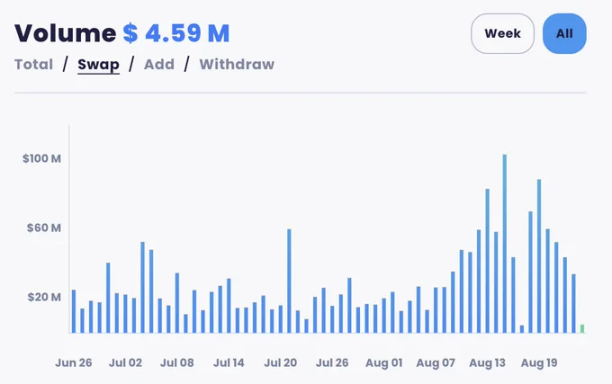Looking at the latest developments of THORChain from both the bullish and bearish perspectives liquidity exchange and lending.
Analyzing the recent developments in THORChain's liquidity exchange and lending from both bullish and bearish perspectives.Author: Rainy Sleep
$RUNE is a token that has recently attracted widespread attention. It has risen due to two positive developments from @THORChain and has become a gathering place for the bearish due to the positive developments being implemented.
Today, I hope to analyze the two updates of the protocol from two perspectives: bullish and bearish. This analysis will cover patterns, flywheels, and risks. 🧵🧵👇
Bullish
The first update is “Streaming Swap”, which is a way to execute cross-chain transactions by splitting large orders into smaller orders. This provides users with a more friendly exchange experience (price) with lower slippage. The impact of this feature on the token price is not direct. There will be a transmission process caused by the increase in data.
- Aside from the lack of tokens, why is it said that Coinbase’s Base chain does not violate US laws?
- Base and Optimism reach a ‘shared revenue’ agreement, pioneering the ‘Layer2 Economic Alliance’.
- An Analysis of the ‘Nintendo’ of the Cryptocurrency World Treasure DAO
For a more intuitive understanding of this data change, let’s look at the graph below. After the introduction of Streaming Swap, there was a significant increase in Thorswap’s data, but the trading volume started to decline significantly after a brief increase. Whether the impact of Streaming Swap is sustainable remains to be seen over time.
Another important feature is Lending, but Lending is relatively complex. I will simplify the logic in a longer format. (Personal understanding, if there are any misunderstandings, please correct me.)
To simplify the lending model, we can understand it like this ⬇️
If we deposit $10 worth of $BTC as collateral, Thor will convert it into Tor.BTC. The path is as follows: BTC -> RUNE -> destruction of RUNE and minting of Tor.BTC. If the loan-to-value ratio (LTV) is 30%, then we can borrow 3 TOR (accounting unit, 1 TOR = 1u). If we want to borrow 3u of ETH, the protocol will mint 3u of $RUNE and exchange it for $ETH to give to the user. Repayment is calculated based on the borrowed amount in USD, not based on the underlying currency.
Next, let’s introduce the most important concept: no liquidation, no interest, and no expiration date.
Why does Thor dare to do this? It’s because it has turned your collateral into $RUNE. It doesn’t need you to repay the loan. Its goal is to minimize your desire to repay the loan—it has already converted your core assets into $RUNE.
When you withdraw your collateral, if the value of $BTC/$RUNE remains unchanged, no additional operations are required. However, if the price of $BTC relative to $RUNE appreciates, Thor will need to mint additional $RUNE to make up for the price difference.
For example, if 10u of $BTC doubles to 20u and the price of $RUNE remains the same, then Thor will need to mint an additional 10u (inflation).
Therefore, it actually doesn’t want you to withdraw your collateral. If you don’t repay the loan, it can maintain the state of destroying $RUNE continuously. (The loan must be repaid at least 30 days later.)
This is a small flywheel constructed by Thor.
Of course, Tor.BTC is not completely supported by $RUNE alone. It is supported by 50% $RUNE + 50% $BTC. This reduces the protocol’s risk exposure. In other words, if the collateral appreciates, it only needs to mint half of the $RUNE to repay the collateral.
This is my understanding of the fundamental motivation of no settlement, no interest, and no expiration date – to exchange your core assets for protocol native tokens. From a long perspective, both new products (Streaming Swap increases user trading volume, Lending involves multiple token conversions and also increases trading volume) will increase the trading volume of ThorSwap and the destruction of $RUNE, which is definitely bullish.
Currently, the protocol lending only supports $BTC and $ETH, and support for more Layer1 assets will be added in the future. Lending is also a DeFi Lego of Tor.Asset, and Thor may launch new products adapted to Tor.Asset in the future to increase the capital utilization of ThorSwap LP.
Bearish
If the reason for being bullish is deflation, then the main reason for being bearish is the potential risks brought by the lending product to the protocol. Although the protocol can control the debt scale through circuit breakers, it is also possible that during the rise, especially when the performance of $RUNE is not as good as that of the collateral assets, it will cause excessive inflation of $RUNE (up to a maximum of 15 million, with a cap of 500 million).
If the upper limit is reached, it would be impolite for the collateral assets to rise again (mainly based on the ratio of Asset/$RUNE), which will generate more risks – bad debts, and the protocol can only solve the bad debt problem with the money from the treasury.
Essentially, Thor’s Lending module transfers risks to the protocol itself and $RUNE holders. Moreover, due to the need for several swaps in Thor’s products, the wear and tear of lending will be relatively large, and the user experience is not friendly.
At the same time, the protocol limits the loan amount to 500 $RUNE (currently about 7-8 million USD), and the loan amount of the protocol will only increase as the number of $RUNE burned increases. With the expansion of the lending scale, it is highly probable that the upper limit of 15 million $RUNE will not be able to meet the occurrence of a bank run.
Although Thor has an upward spiral, it also risks burying itself in a death spiral – if the newly issued 15 million $RUNE and treasury funds cannot meet the requirements of a bank run, then Thor will enter a death spiral.
Therefore, we can also understand why Thor’s collateral ratio is set at 200%-500%, not giving users the opportunity for high leverage, and why the protocol reduces the loan-to-value (LTV) as the collateral increases. However, a lower LTV will reduce the adoption of the product, leading to the inability to start the upward spiral.
Therefore, Lending has become a relatively mediocre product, which does not bring significant improvements to the protocol. It is a pity to abandon it, and there is not much to do if not bearish.
After reading this analysis, what will be your choice? The red pill or the blue pill?
We will continue to update Blocking; if you have any questions or suggestions, please contact us!
Was this article helpful?
93 out of 132 found this helpful
Related articles
- PEPE plummeted by 16%, and the founder behind it was exposed a 97-year-old photographer who used the money from selling coins to buy a Lamborghini.
- Deep analysis of governance risks, capital risks, and protocol risks of LSD.
- AI FOMO sweeps the world profits surge 8 times, NVIDIA emerges as the biggest winner.
- Experience the Tu Dog hype type SocialFi platform friend.tech it may be boring and even ridiculous at times, but it has unlimited potential.
- What is the security foundation of the post-POS era? A quick look at the newly proposed theory in the Ethereum community, Proof of Validator
- An Overview of Scroll’s Early Ecosystem What Opportunities Exist for Leading Players in zkEVM?
- The wave of Layer1&Layer2 has arrived, taking stock of the token bridging steps and potential opportunities of various new chains.







